The consumption of Sicilian red oranges: implications for firms involved in commercialization
Abstract: We have carried out research at the University of Catania on the consumption of Sicilian blood oranges. In particular, the aim of our marker survey has been to assess the role of demand of these citruses, characterized by high health value and produced exclusively in Sicily (above all in Catania area), on commercial firms’ trade strategies. This marker survey carried out an interview, administering an appropriate questionnaire to 20 groups of anonymous foreign consumers of several races (all European countries), during their holiday stays in Sicily. The main outcome regards worldwide interest in fresh orange juice because it keeps the raw materials unchanged in terms of original features and properties, in particular anthocyanins and vitamin C, especially now that the red colour of the Sicilian orange is no longer an off-limit factor to customer consumption. The widespread demand of Sicilian blood oranges has oriented the firms involved in their commercialization to keep or widen foreign markets, in which there are increasing needs for well-being and health.
Introduction
This work is part of a research program of the firms involved in commercialization citrus fruit in the main area of production in Italy [21] – in particular, the province of Catania, Sicily– since 2001. It aims at pointing out the most important changes that occurred within the various aspects of company management – in terms of supply, production, marketing, etc. – and at orienting competition. These changes are the result of the new scenarios concerning the distribution system of agricultural and food products. Such scenarios are increasingly influenced by the qualities of products and also by changes in people’s habits and consumers’ new living styles. They are also influenced both by the various ways and places in which products are consumed, and the effect of the growing liberalization process of international exchanges. As far as orange production is concerned, this liberalization has negatively influenced Italian export trends, as its attendant volumes have been decreasing, especially since the beginning of the ‘90s. This is due to the abolition of the phytosanitary boundary at the Italian frontier, first towards other EU Countries (1993), second towards third countries (1997), by turning the home market from a “closed” into an “open” one (Sturiale, 2001). Moreover, this phenomenon has been influenced by the Multilateral Agreements on agriculture of the World Trade Organization and the foundation of a free exchange area within the Mediterranean – Euro Mediterranean Partenariat – between the European Union and some countries in North Africa and in Middle East overlooking the Mediterranean Sea.
Such crucial events have obviously affected the entire orange growing industry (and also the other types of citrus production, to different extent though) in Italy, and particularly the Sicilian one, although Sicilian oranges are mainly characterised by “red” (blood) oranges (“Tarocco”, “Moro” and “Sanguinello”). [22]
Production and Health Effect
In fact, the best quality of the Sicilian orange supply is represented by the production of pigmented oranges, having some special flavor and organoleptic characteristics that cannot be found outside Sicily, and in particular outside the east side of Sicily and in the south and south-west of Mount Etna (additional information concerning this issue can be found in point 2). It is in this part of the island – nowhere else in the Mediterranean or in America – that these oranges have found the right environmental conditions to best show their genetic characteristics, such as their intense red colour and the perfect acid/sugar ratio.[17]
Red orange growing in Sicily (figure 1) is extremely important in some areas (figure 2), which are specifically suitable for their pedological and weather conditions. Temperature ranges between morning and night, sometimes of beyond 20° C, contribute to the synthesis of anthocyanins. The characteristics of the land and climate are essential for producing the pigments that give red oranges their characteristic colour in some Sicilian territories. The essential factor is, indeed, whether the above-mentioned sudden change in temperature occurs when oranges ripen. This phenomenon, a characteristic of the Mediterranean, does not exist in tropical areas from which citrus fruits come.
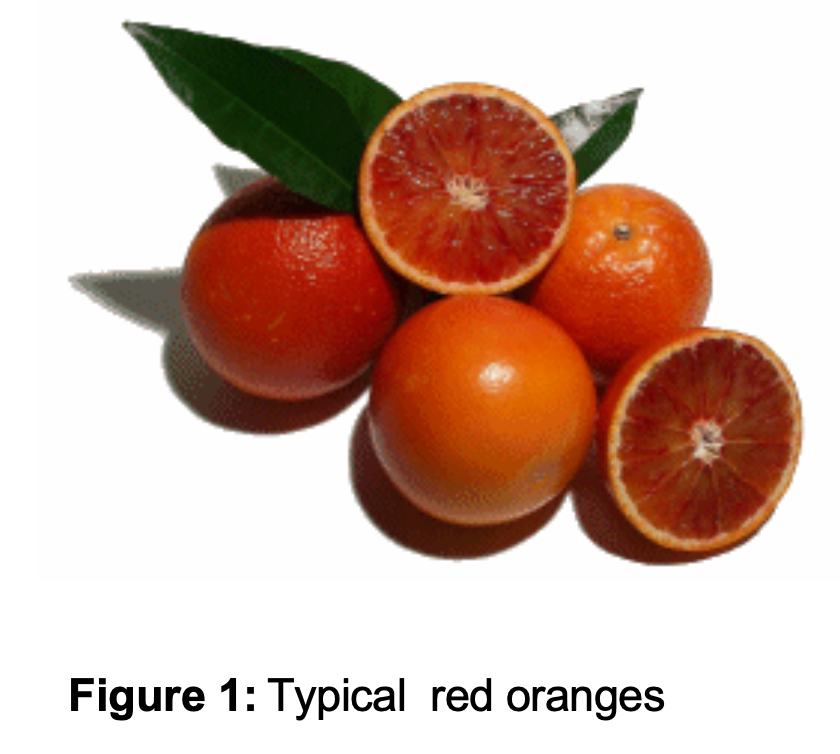
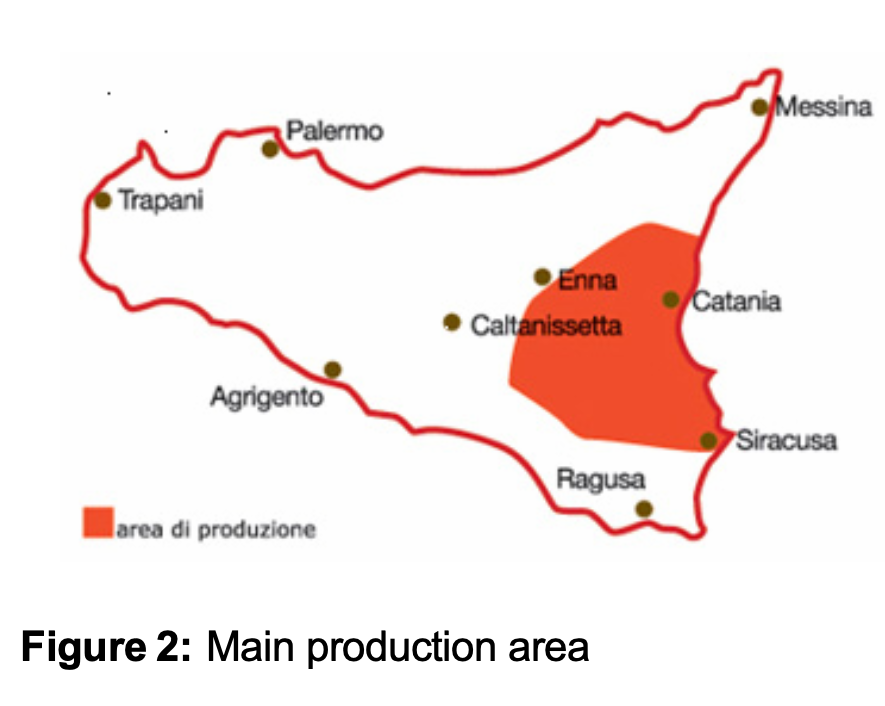
This provides fruits with valuable, unique organoleptic characteristics. The prevailing anthocyanin in blood oranges is the cyanidin-3- glucoside, which has a powerful antioxidant action and is therefore useful in preventing cardiovascular diseases and the development of some types of cancer. They also reduce the effects of ageing and help to prevent hypercholesterolemia.
Although not the focus of this paper, we would like to mention the health value of blood oranges, and in particular the so-called precious compounds and their functions. They represent necessary conditions for our detailed analysis on orange consumption. Among the most precious contents of pigmented oranges there are anthocyanins that do not exist in blonde varieties. Not only do these pigments give an essential sensory contribution, as they help typify the product and promote its image, but they also play a more important biological role. In fact, they are used in ophthalmologic therapy as active principles; they contribute to the regeneration of the visual purpura in the treatment of ulcers and in angiology, thanks to their epithelium-repairing and capillary-permeability modulating properties. They are also used in those physiopathological conditions characterised by an excessive production of free radicals. [14]
Besides, recent research has established that pigmented orange juice has greater antioxidant action than blonde orange juice. The latter seems to contain a high percentage of vitamin C, HCA (acidi idrossicinnamici) and an exclusive quantity of anthocyanins. [17] As it is known, vitamin C boosts the immune system while HCA are juice- exclusive antioxidant elements. Eating two blood oranges per day provides the right daily quantity of vitamin C, which is necessary for the human body. [14]
With respect to their peculiar biological characteristics and their unique geographical origin, Sicilian blood oranges have gained the PGI EU recognition (Protected Geographical Origin), according to the EC Regulation n. 1107/96 and the consequent “Disciplinare di Produzione Arancia rossa di Sicilia” (Circolare del Ministero per le Politiche Agricole – Gazzetta Ufficiale Repubblica Italiana n. 240 on 14th October 1997).
Problems and economic challenges
Basically, we are in front of an exclusive product, which however shows some economic problems; these are equal to those registered for some other less precious citrus grown commercially.
In this connection, remember that the citrus market, especially the orange one, is a gross market with a differentiated character (imperfect market), which includes fresh fruit as well as fruit juices in both supply and demand. It is to be underlined in any case that on a world scale and with reference to importation markets – involving European countries above all – fresh fruit is heavily affected by fruit juices coming from American-producing export countries, such as the USA, Mexico, Cuba, and Argentina, which are much more competitive than European citrus- producing ones, such as Italy, Spain, and Greece, for multiple reasons [5], including:
- The development of a process for the concentration of juice and cold storage of fruit juices that emphasizes the characteristics of oranges and meets final consumers’ needs.
- Transportation and storage allow fruit juices to be transported at low cost in comparison with natural fruit juices and fresh fruit, and allow products reaching close and/or distant consumer markets, such as European ones and others.
- The development of a low-cost, industrialized citrus production based on foreign consumer markets
- The potential supply of citrus fruits throughout the year, especially in Western Europe, where fresh fruit demand could not or at most partially met during the summer (see importation from the Southern hemisphere, especially South Africa).
- US Dollar weakness versus the Euro.
Another important aspect is that such exchange undergoes horizontal integration processes initiated by companies that are supported by local governments. These companies can be private or capitalistic or can include cooperatives. In Italy, with reference to the Sicilian territory, fruit juice producing companies are well integrated with each other and have come to simple agreements they respect. Nevertheless, they suffer from the above- mentioned reasons for competition, which affects importation markets from overseas.
Concerning fresh orange consumption, competitors for European importation markets dealing with Sicilian oranges are the same orange- producing and trading companies that belong to the European Union, such as Spain, Greece, Cyprus and others, as well as the third-world countries of the Mediterranean Basin, such as Morocco, Egypt, Turkey and others.
The production of “red” oranges in Sicily (Figure 3) brought back from Italian official statistics (National Institute of Statistics – ISTAT) has only recently overcome one thousand tons. Although a great increase in production has been registered, the product exportation seems to be very limited, as it is characterised by minimal volumes with a low percentage. Exportation growth seems to be stable or slightly declining (Figure 4). It can be traced back mainly to the growing presence of other countries (Spain, Greece, Morocco, Turkey) on main citrus markets. These countries are able to compete thanks to a price policy, which is fostered by their extremely low factor costs. On the other hand, there is no appropriate and effective policy aimed at promoting those productions, even if Sicilian productions have nearly unrivalled qualities. Our country has not done enough to develop organisation models fit for carrying out adequate policies for product differentiation.
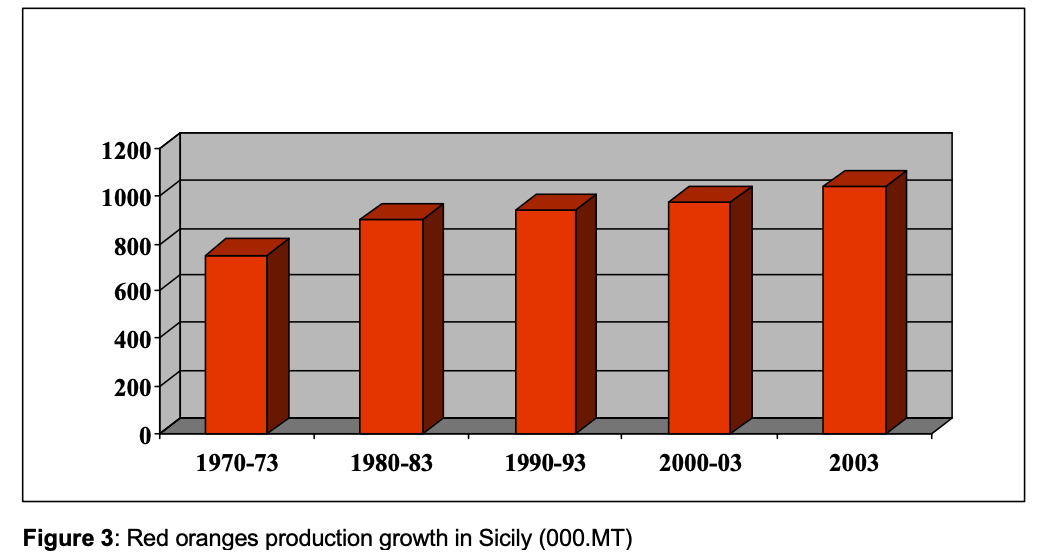
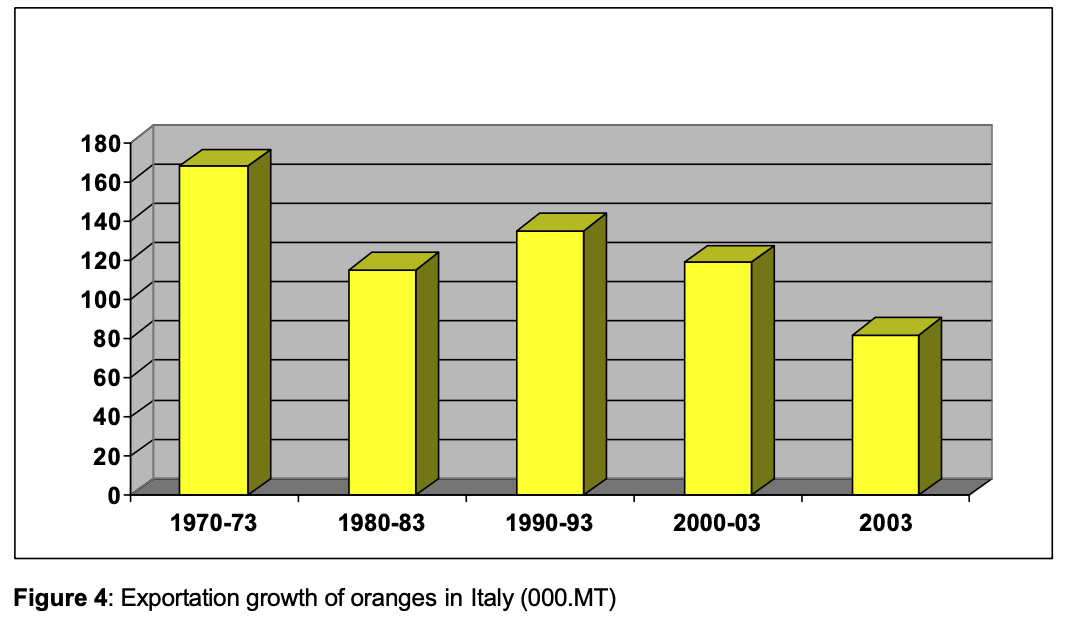
Compared to blonde ones, red oranges have a lower penetration capacity into consumers’ shopping carts. This is true for juice consumption, too, as shown by the surveys carried out in some European countries on Sicilian red orange juice consumption. [18]
On one side, this was due sometimes to the ‘intense red’ colour of the pulp of Sicilian oranges, which recall the colour of ‘blood’, and on the other side to the minimal knowledge people had about the higher nutritional characteristics of this kind of orange, to which consumers have only recently assigned a privileged role.
To this purpose, it is useful to remember that relationships with suppliers are extremely important, especially for those commercial firms that aim at quality and differentiation in terms of strategic placement. [1] Besides, we need to point out the existence in Sicily of a distribution system scarcely developed and made up of small and very small enterprises.
The length of the distribution channel affects profits as well, because costs are higher and include the purchase of raw materials, refrigeration, packaging, transportation, and mediation. The lower return are also caused by controlled and non-competitive prices compared to the ones offered by extra-European competing countries.
Blood oranges are one of the agricultural and food products mostly involved in competition within the nets of the modern-scale retail trade. In fact, among various points of sale, great relevance is given to reasonable prices, quality, customer service and an everlasting demand of these products, as they are considered essential factors in competition.
For this reason, it is to be hoped that fresh blood orange firms involved in commercialization take into account specific strategies aimed at promoting favourable competition, which will enable them to take advantage from an unrivalled position compared to their own competitors. [15] The Italian market is mature indeed. Here, in fact, is where most of Sicilian red orange production is consumed and where ad hoc market research hasbeen carried out. The most recent is that of Sturiale, 2001.
We wanted to analyze the different cultivators of red oranges, together with productions having those characteristics that consumers demand. Currently “Tarocco” definitely prevails among all the pigmented oranges with 58%, whereas “Moro” and “Sanguinello” come after with reduced shares at 20 – 22 %. “Tarocco”, a probable mutation of “Sanguinello”, takes its origin at the beginning of the century in Francofonte (Siracusa). Several clones (Tarocco Gallo, Scirè, Sciara e Cocuzza) due to the different pedoclimatic conditions of various growing environments give birth to a large ripening calendar from the beginning of December to April.
Aims and Scope
In such a situation, in which the demands for products have good requisites, including dietetic, healthy and sanitary ones, are increasing, this work aimed at locating hidden opportunities to enlarge the market of Sicilian blood oranges. That is to say, red oranges could take advantage from those market sections, which still have some great potential. They could, therefore, represent a remarkable commercial opportunity for those firms involved in the commercialization of fresh red oranges, and especially for those that pay more attention to changes occurring in product consumption and consumers’ tastes.
This is why this work has been conducted. We have researched foreign consumers in order to verify whether it is possible to introduce the two typologies of Sicilian oranges – red and blonde – in different markets. In fact, they have been proven in scientific tests to have different organoleptic–sensory and chemical characteristics. As far as red oranges are concerned, our survey also aimed at measuring to what level the red colour can affect consumption of both fresh oranges and red orange juices, seen that somehow the blood-like colour of the pigmented pulp has been a prejudice.
Our research has been intended to provide analytical tools and information to trading companies for them to have a better knowledge about both the adaptation dynamics surrounding common strategy development for products, and strategy flexibility at individual and collective levels. Flexibility, in fact, is necessary to highlight the differentiation potential of red oranges to enter the market.
Among the different typologies of consumers we have deemed it interesting to alert foreigners, and have seen that field experts think the red orange market is expanding, especially as far as juice consumption is concerned. [19] The maturity phase for red orange juice, in fact, is longer in comparison with that of blonde oranges.
This survey was carried out among tourists visiting Sicily to highlight the purchasing behaviour and store problems of different European countries, taking into consideration the intensity of population in metropolitan areas and peripheral cities as well as the age of consumers, so to individualize the preferences with regard to the psycho-emotional approach. [12]
That research has been a valid and useful contribution to show orange consumption trends and what consumers prefer among existing product typologies, in order to explain critical points. In particular, it pointed out interesting factors for a successful and renovated Sicilian orange growing.
Materials and Methods
In the last few years, a phychological status called “subjective well-being” has spread among developed countries’ populations. This is due, on one hand, to a remarkable improvement of socio- economic conditions and standard of living across social classes, and on the other hand to a progressive increase in life expectancy. In every single consumer, this situation gives birth first to an privileging of taste and product aesthetic appearance, then to a new interest in condition and body care measured for homogeneous groups in terms of race, sex, age. The shift from immaterial to material dimension of one’s own subjectivity can take place within an actual pathological status, which can sometimes be treated by interventions regarding “nutrition therapy” domain. [9]
According to this presentation, consumption models are rather distinct among various agricultural and food products. Therefore, it is necessary to investigate people’s tendency to eat such blood oranges, on the hypothesis that fact- finding elements could be implemented to identify new commercial logics based on competitive advantages. In this situation, if we look at foreignmarkets, where fairly small quantities of oranges are sent today, the Italian market represents the prevailing commercial outlet for blood oranges.
This inquiry was addressed to some tourists on holiday in the winter and spring of 2003-2004 (during orange-growing season) in one of the most important Sicilian tourist resorts (Ragusa), where, however, there is no blood orange growing. This inquiry was carried out by the use of face-to-face interviews by a questionnaire which was given in a public hotel-restaurant-bar in the town centre. This technique enabled us to obtain answers with a high level of reliability and to reduce to a great extent evasive ones.
The reason for choosing such inquiry in Sicily, apart from the lack of economic founds suitable to carry out a study with direct surveys in various countries, was also due to the fact that some tourists consider their holidays in Sicily an opportunity to eat typical and traditional agricultural products, which remind them of Sicily’s “nature, sun and landscape” and the “authenticity, quality and taste” of its local products. Their most appreciated products are, therefore, “Sicilian blood oranges”. [18]
The questionnaire was made up of some binary or multiple-choice questions referring to some aspects such as quality and quantity. This gave interviewees a great range of options, so that all evasive answers could be reduced. Such options were useful to understand how some special factors affect people’s decisions in buying blood oranges.
In particular, this study let us gather some data and information concerning: 1) consumers’ characteristics (social and demographic data); 2) knowledge about blood oranges (compared to blonde oranges); 3) level of perception of red orange characteristics, with special reference to healthy ones; 4) buying tendency; 5) type of purchase; 6) place to purchase; 7) consumption place.
The questionnaire also included some questions about people’s tendency to have fresh red oranges more than orange juice, which has recently been increasingly drunk in its various versions available on the market. In particular, the orange juice types on which we acquired some information, thanks to this questionnaire, are the following [19]: 1) blood orange juice squeezed shortly before being consumed; 2) chilled fresh 100% blood orange juice; 3) long-life drink with blood orange juice; 4) blonde orange juice; 5) juice mixture (with blood orange).
These questions thus gathered consumers’ opinions about the substitution of fresh blood oranges with squeezed juice, and collected opinions of those consumers exclusively interested in juice, in order to show their different perceptions towards various kinds of juice available on the market and those listed above.
Moreover, during the interviews, interviewees could taste fresh oranges and at least two kinds of orange juice among those above mentioned.
350 interviews were carried out on the whole to 20 groups of 15 people each on average, being at least 25 years old. They constituted a good representative of both their countries of origin (all European countries) and various social, demographic characteristics. They were certainly a plausible market portrayal.
Although we realize that it would have been more important for research purposes to get a greater number of consumers, we deem that the sample encountered by chance was nonetheless sufficiently significant to gather some information on consumer preference and blood oranges’ consumption.
Finally, it is necessary to point out that, while processing data, we did not consider consumers’ homeland as a privileged element in the statistical data collected, but only as a typical aspect of a larger feature such as “foreign country”.
The aforementioned decision to unify our sample under the comprehensive meaning of “foreign” does not invalidate the result of our inquiry. In fact, all places of origin are included in a larger and more important international geographic area of agricultural and food products distribution. In this case, however, this area is characterised by a homogenous type of market, which can be ascribed to “imperfect market” (bilateral oligopoly).
Results
In order to highlight the importance of oranges within the “big European agro food market”, data from official FAO (Food and Agriculture Organization) statistics have been elaborated.
In particular we started from the four-year average commercial balance of orange-derived products (table 1, appendix) in the years 1980/83 and 2000/03. Working with averages levels production jumps, which often characterize yields from year to year, as well as possible perturbations over market trends.
We also applied some coefficients to the juice- related balance to convert juice quantities into fresh orange ones (tables 2 and table 3, appendix). It was then possible to highlight the dynamics trend of the average orange quantity available per person in the European Union, of which we include 15 countries.
Unfortunately, more recent data were not available, so we could not study this phenomenon with respect to the current situation, which includes 25 countries. In twenty years, there has been a progressive growth throughout the Continent, which except for a growth at the beginning, was quite steady during the following years (table 4) due to a heavy growth of population during 1990/93 and 2000/03.
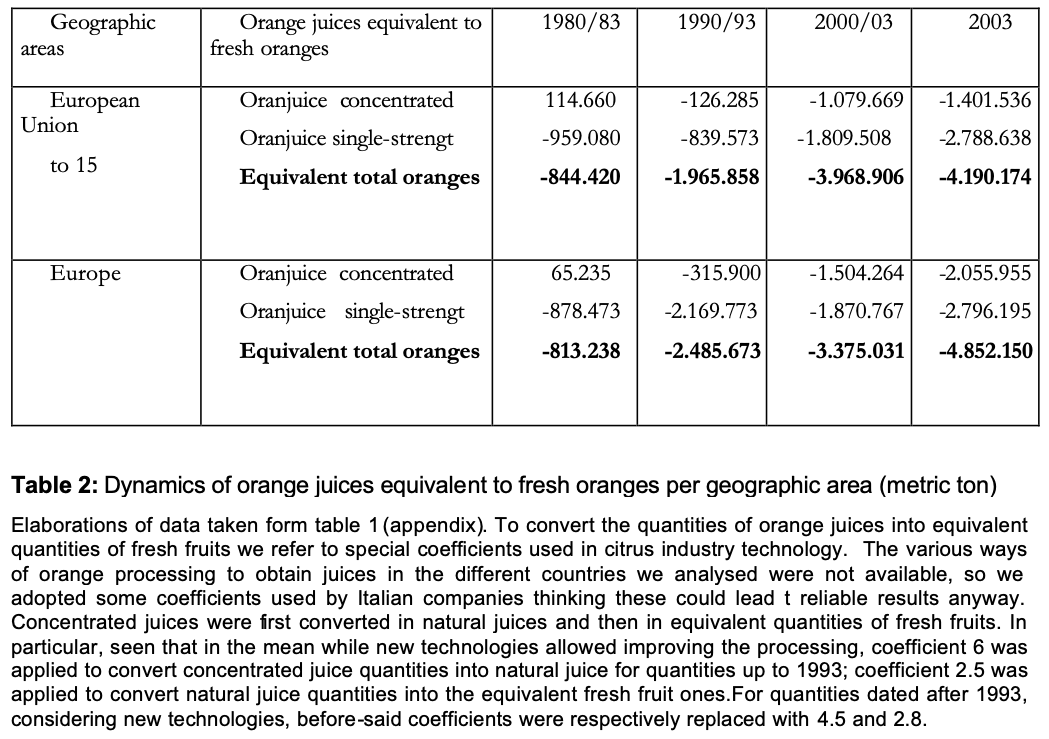
Questionnaire Results
The socio-demographic profile of people interviewed is reported on table 5 (appendix). The characters depending on the geographic collocation, Sicilian origin and the regular consumption of red or blonde oranges are shown on table 6 (see appendix).
Questions made to establish the position of blood oranges compared to that of blonde ones had answers in favour of pigmented oranges. For the most part, people considered pigmented oranges a “typical product” and supported it for its contents; that is, anthocyanins and vitamins. Among others of their quality characteristics, there are “healthy value”, “best taste” and nutrients.
With respect to this, we verified whether the preference towards blonde flesh oranges could be linked to a “prejudice” due to the intense red colour of Sicilian pigmented oranges.
Our questionnaire also included some questions aimed at analysing the replacement effect between the consumption of fresh products and orange juice. The latter turned out to be the biggest competitor of natural red oranges (table 7, appendix). People answered that they prefer not to peel. However, some people declared to prefer fresh oranges, but of the “Tarocco” variety, because they look typically Sicilian, their flesh is more consistent, and they are very easy to peel.
As far as fruit juice competitors of natural fresh products, people focused their attention on orange juice (spremuta) (table 8, appendix), that is, on the orange manually crushed and reduced to juice in the glass.
Concerning orange juices, people were asked to indicate which one of the two typologies they prefer, “100% fresh refrigerated blood orange juice” or “long life blood-orange-based drink”. 68.6% said they prefer the first one, provided a wide shelf-life, while 25.4% prefer the second one. for the remaining 6% both typologies are the same. (graph 3).
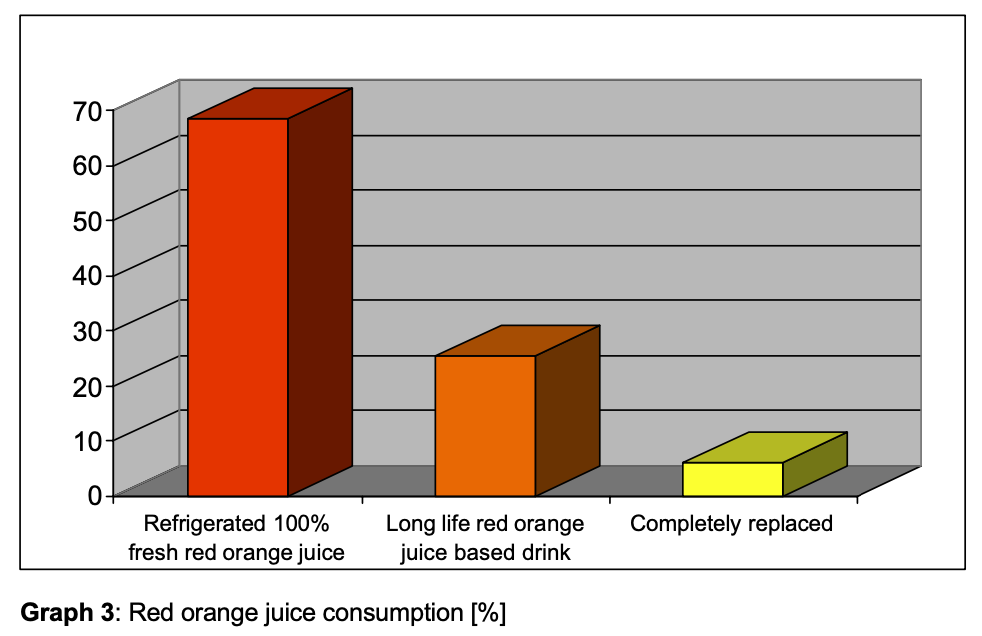
As regards the two typologies, “blonde orange” juice and “blood orange” juice, the first one is preferred as a refreshing drink. The same preference is for juice mix, that is, with blood orange (table 9, appendix).
As far as food habits are concerned, see table 10.
People who buy fresh orange-based products prefer small packs with graphic characterization of packages. Few like the self-service sale of great- scale retail trade. For juices, instead, no preferences concerning packaging came out. In this case, attention is paid towards seals, among which people prefer more the “save and close lid” and less the “screw top”.
Our research helped us draw a picture of all typologies of usage involving blood oranges. This picture is not characterized by great differences in consumers’ behaviour, even if they come from different places. In a word, answers appeared to be homogeneous, allowing our survey to obtain very significant results about Sicilian blood oranges’ consumption.
Conclusions
1. The results of our research can be considered satisfactory because they showed a positive trend for red orange consumption, even if the research involved a consumer target that did not completely cover the scenario of red oranges’ introduction.
In this regard, the survey highlighted the need to intervene to improve the knowledge extant on red oranges’ characteristics, against the low perception of final consumers, and to increase the product range offered in points of sale.
This survey, even if limited to tourist- consumers on holiday in Sicily, allowed us to verify which factors play important roles in individual blood orange consumption, as well as realize the presence of distinct profiles in fresh or processed product consumption. For processed products, we refer to orange juices. It is clear that pigmented orange consumption depends on the characteristics of the group that tourist-consumers belong to, such as the place they come from, and their age and occupation.
Analysis of data showed two consumer profiles: a health-oriented consumption of blood oranges, characteristic of older people; and a juice-oriented one, with people preferring fresh- like juices.
Orange juices are preferred because they are timesaving. Time saving characterizes many commercial products, especially product typologies, commercial services and information sources. Consumption, in fact, is made up of different steps: “what” to buy and eat; “where” to buy, and “when” and “how” to consume (Belletti, 1995), including the “way” how to obtain information about products.
It is interesting to point out that the results of the survey carried out among tourists in Sicily led to the same conclusion. It used analogue research models over red orange juice consumption (Sturiale, 1995 and 2001) and established that the product was natural, healthy, rich in vitamins, and tasty, with a snappy colour and attractive specialty.
The results also confirmed the tendency to choose ‘niche’ products of those consumers living in well-to-do metropolitan areas. They prefer innovative products and are predisposed to favor typical Sicilian goods.
A negative factor for the development of the demand is the co-presence of numerous typologies of fresh oranges into the market in different sizes and of fruit juices that confuse final consumers. The appellation “IGP Arancia rossa di Sicilia” (IGP Sicilian red orange) aims at favouring and consolidating the privileged position in the preference scale of consumers.
In conclusion, it is necessary to point out that the qualitative aspect of our survey showed a limit as far as the spending capacity of the surveyed sample is concerned. In fact, sale prices of orange- derived products considered were not available, so that we could not individualize a relationship between the “taste” of consumers and the limits of their financial balance, including the relative consumption quantities. Notice that, research carried out directly on the spot can provide data on consumer preferences concerning red orange products. In such a context, fresh orange firms involved in commercialisation have to choose correct strategies, including on one side, a reduction of the number of firms, and on the other, a change of the market relationships with firms involved in the processing of products, aiming at carrying out a vertical integration between the two.
In other words, this means that the future of Sicilian firms involved in the commercialisation of citrus fruit is strictly bound to their ability to produce highly differentiated products and personalized services. It has to be considered that those firms involved in blood orange market, today in particular, aim at niche markets that force consumers to chose among smaller and smaller but also more numerous market scopes.
Thus, in the final analysis, for the Sicilian blood oranges, will be the most important one in the next years; this is also proven from some recent initiatives conducted in North America from private/public organizations and of the Sicily Region. We refer, on one hand, to a recent survey lead in Canada on the consumption of Sicilian agricultural and food products, which catalogued the presence of Tarocco blood oranges in supermarkets in Toronto and Guelph (Bellia, 2004); on the other hand, to the operation “Sweet Peel” that an crescent has activated flow of Tarocco oranges from the Sicily in the USA, and moreover to the initiative to valorize such citrus fruit in the international fair of agricultural and food products (Fancy Food, New York). In such contexts, Italian-Americans carry on an important role as a segment of consumers interested in the Mediterranean diet and the memories of their or their relative`s origi ns. Finally, other trade initiatives have been under way in Japan and Australia.
The trades, for the next citrus fruit campaign (2005-2006), preview a flow of Tarocco oranges from Sicily towards the North American Continent approximating 4.500-5.000 metric tons, while towards Japan the amounts are equal to 8.600 metric tons.
2. Sicilian orange growing plays an important role in health and nutrition. Its survival and development will depend on the ability of people involved in this field to carry out and evaluate the innovations that research provides (Bellia 2003), then modify their products’ processing and organization. Basilar as well as some innovations involving cultivation on the field, such as the introduction of automated water distribution, mechanized pruning, antifrost system and other programmed treatments (Polyhuard), are needed. Antifrost carried out by means of automated devices, which has been dealt with in several studies (Pulvirenti, 1995), seems to be very interesting for the very preservation of pigmented flesh cultivars. It also allows for orange growing even in cold areas experiencing frost during winter, which, however, are the best for growing red oranges. The thermal limit—that is, the change in temperature between day and night—is the first cause of yield damage and can thus be reduced, allowing productions to still take advantage from the sudden change in temperature of these areas, which is particularly good for the “reds”. Innovations are to be extended over the production phase. That means processing in order to provide new fresh products, such as fresh juices from juice-dispenser machines – Oranfresh, chilled or frozen ones—and distribution thinking of new packaging for fresh fruits and processed products (juices).
Last, but not least, the settlement of quality trademarks, geographical indications, and production details, specifying whether it is a eco- compatible production or an integrated one, all present important strategies to distinguish and differentiate products at market level.
Acknowledgment
The research was financed from the National Institute of Economy Agriculture (INEA), Rome.
A.S. Zarbà took care of the entire study, to exclusion of “Production and Health Effects” and of point 2 of of the conclusion, which was done by Pulvirenti G.
Appendix
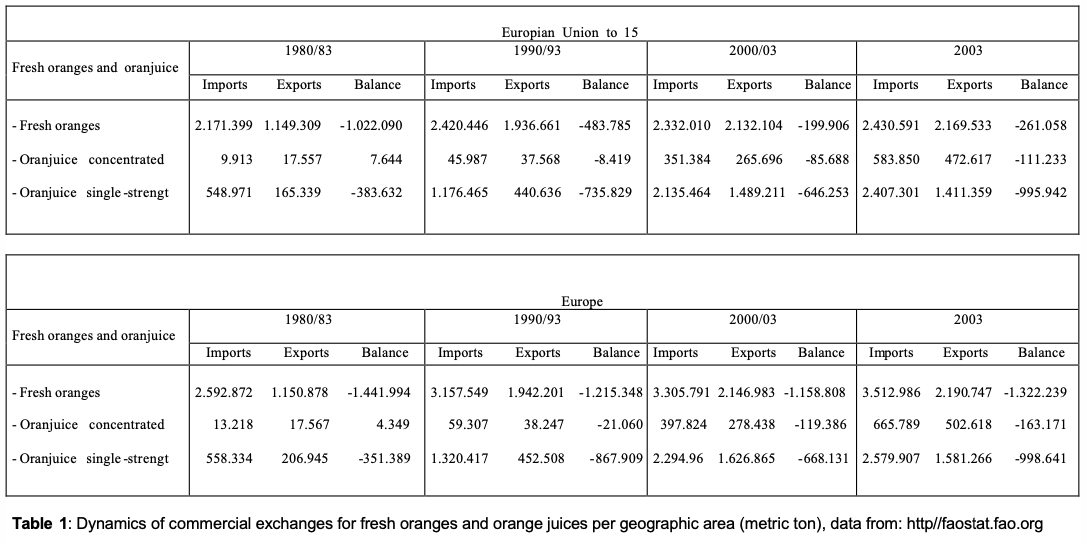
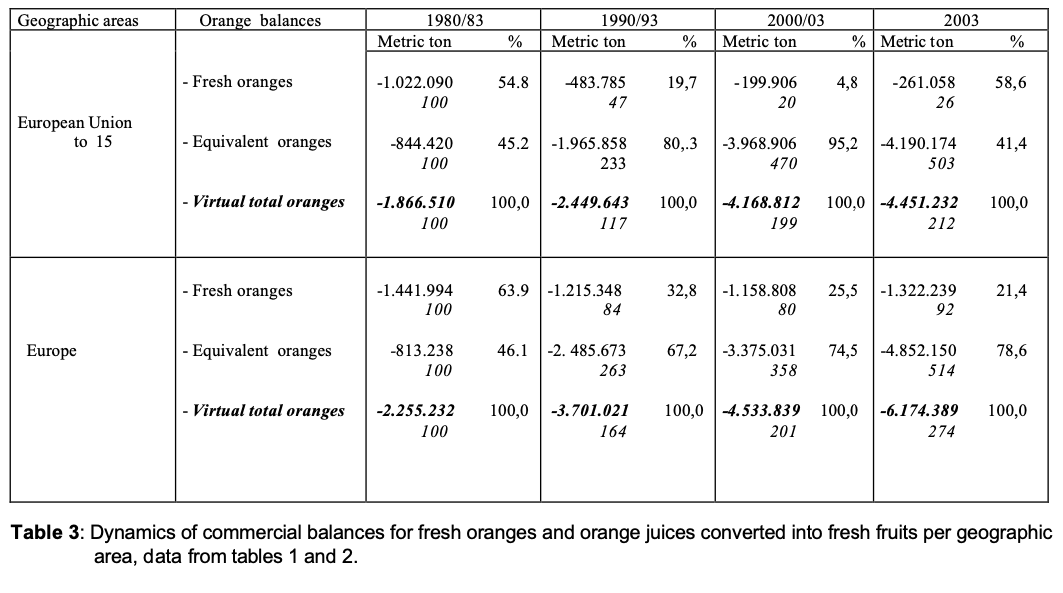
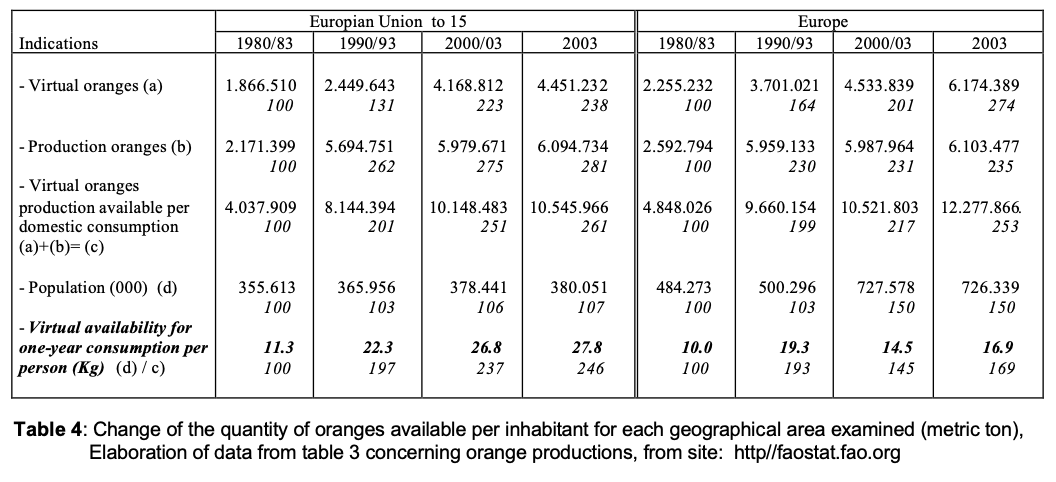
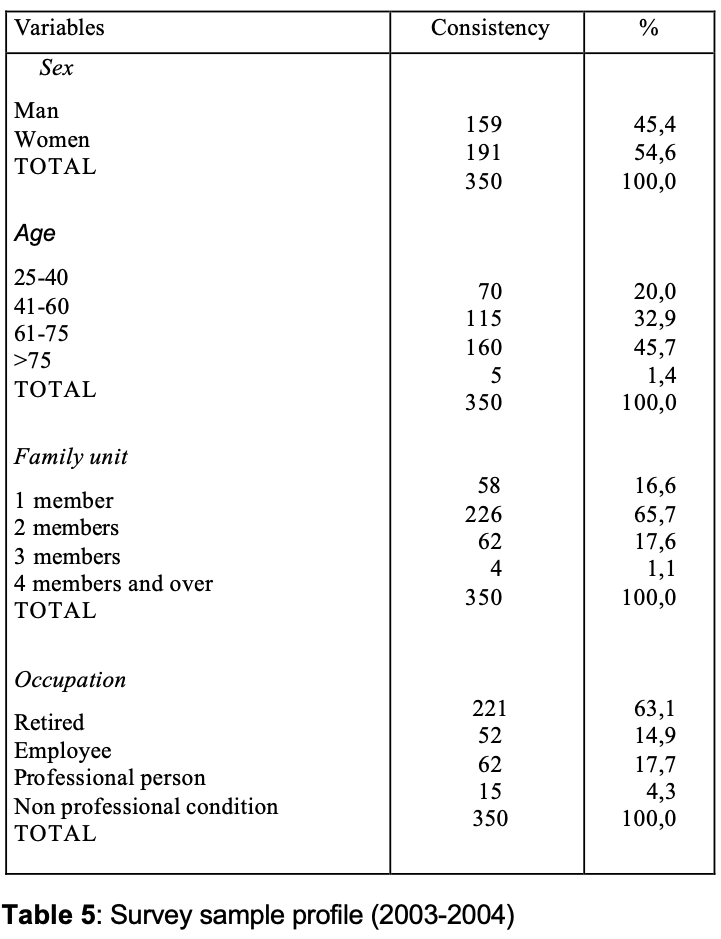
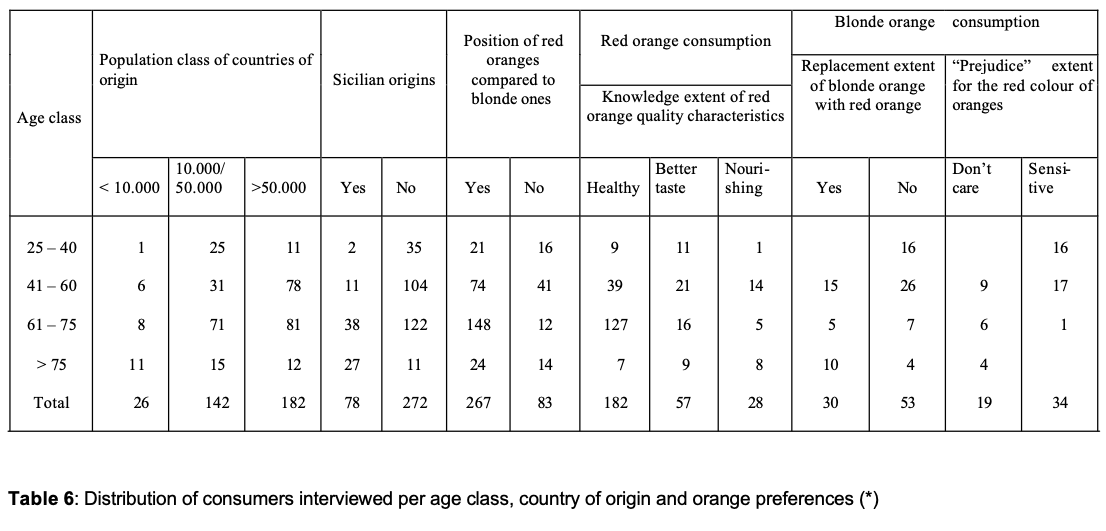
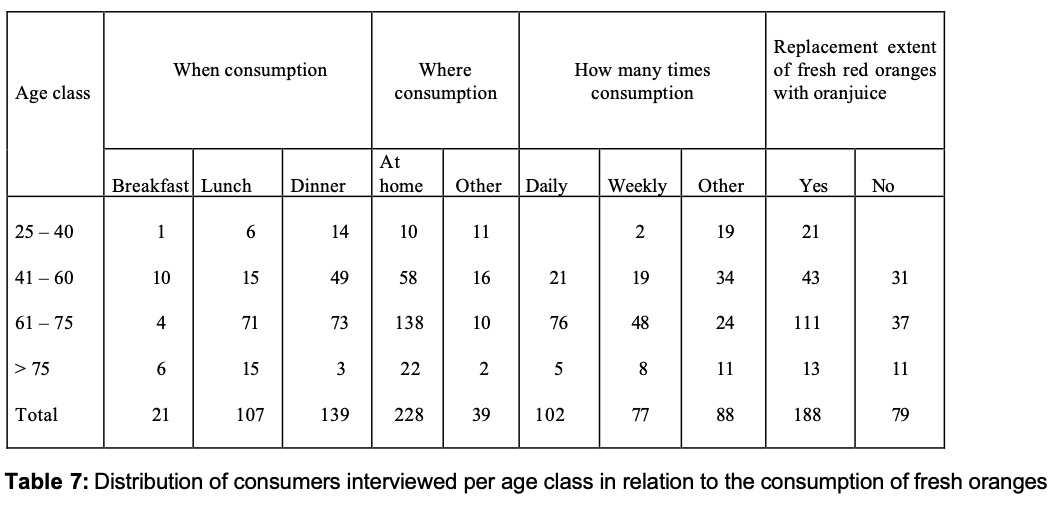
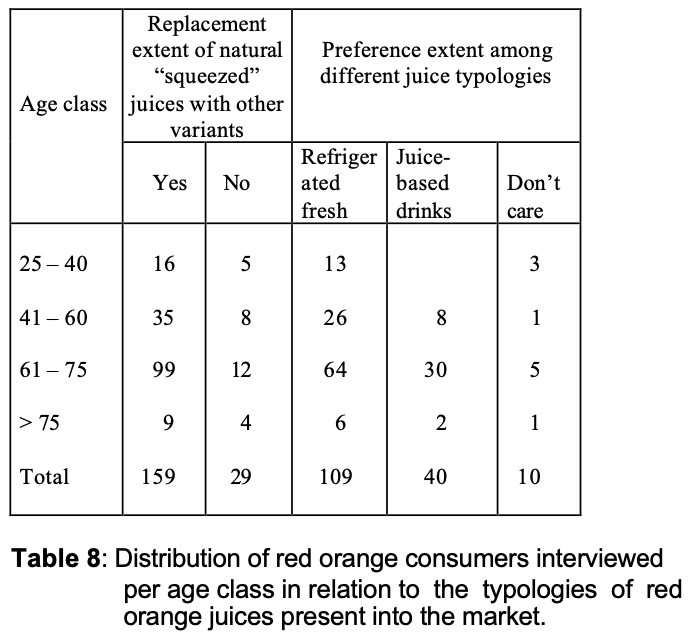
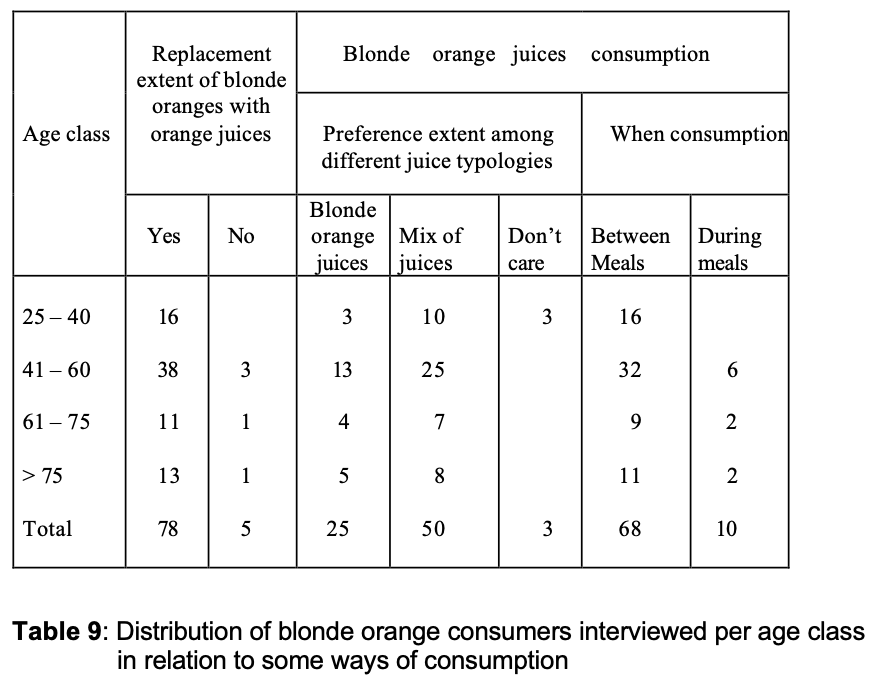
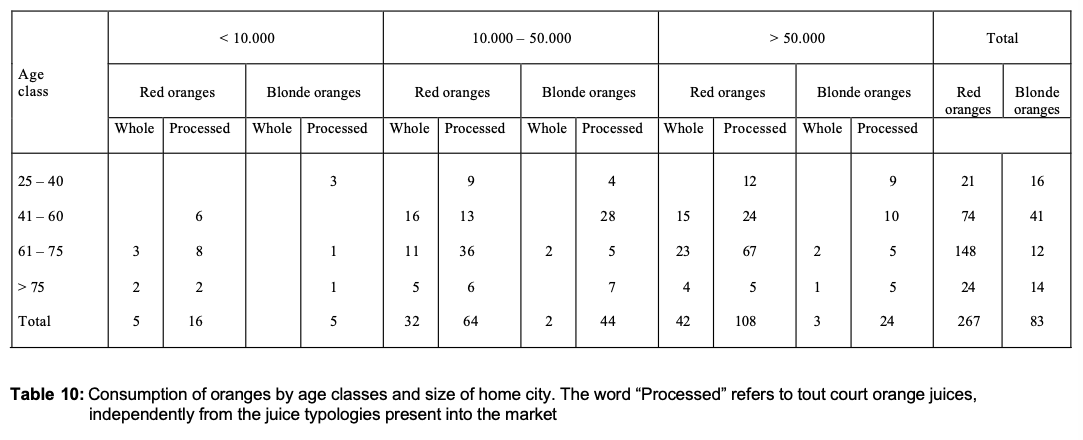
References
[1] Antonelli G., Vigano’ E., 2000: Rapporti verticali e strategie competitive delle imprese agroalimentari: alcune evidenze empiriche, in Economia Agro-alimentare , n.1.
[2] Arena E., Fallico B., Maccarrone E..2000: Influence of carotenoids and pulps on the color modification of blood orange Juce, J. Food Sci. 65, 458-460.
[3] Arena E., Fallico B., Maccarrone E..2001: Thermal damage in blood orange juices. Kinectics of 5-hydroxymethyl-2-furancarboxaldehyde formation from sugars, Internat. J. Food Sci. Technol., 36.
[4] Belletti G., Marescotti A.1995: Le nuove tendenze nei consumi alimentari, in “I prodotti agroalimentari di qualità: organizzazione del sistema delle imprese.
[5] Bellia F., Maugeri G.,. Sturiale C. 1991: Realtà e prospettive della produzione e del mercato degli agrumi in italia, in Studi di Economia e Diritto, n. 4.
[6] Bellia C.,. D’Amico M.. 2003: Analisi delle innovazioni nella filiera agrumicola: effetti economici e diffusione delle imprese. Università degli studi, Catania.
[7] Bellia C. 2004: La presenza dei prodotti agroalimentari della Sicilia in alcuni mercati di consumo canadesi. CORERAS, Palermo.
[8] Chakravorti B. 2004 The new rules of bringing innovations to the market. Harvard Business Review, March.
[9] Colombo E. e Rebughini P., La medicina che cambia. Le terapie non convenzionali in Italia, il Mulino, Bologna 2003.
[10] Galizzi G. 1996: I Sistemi Agroalimentari Europei: Conflitti e convergenze, In Atti del XXXIII Convegno di studi SIDEA, Napoli.
[11] Hirschman E.C., Holbrook M.B. 1982: Hedonic Consuption: Emergine Concepts, Methods, and Propositions, Journal of Marketing, n.46.
[12] Holbrook M.B., Hirschman E.C 1982: The Experiential Aspects of Consuption: Consumer Fantasies, Feelings and Fun, Journal of Consumer Research, n.9.
[13] Maccarrone E. 1997: Dalla Cina a Bruxelles, La lunga marcia delle arance rosse, In Tecnica Agricola, n. 49, Catania.
[14] Maccarrone E. 2004: Composizione e valore salutistico del succo di arance rosse di Sicilia, In Frutticoltura, n. 3.
[15] Porter M.E. 1987: Il vantaggio competitivo, Edizioni Di Comunità, Milano.
[16] Pulvirenti G.: 1995: Analisi economica degli effetti della difesa antigelo a mezzo ventilatori in aziende arancicole. Università degli Studi, Catania .
[17] Rapisarda P., Carollo G., Fallico B., Tomaselli F., Maccarrone E. 1998: Hydroxycinnamic Acids as Markers of Italian blood orange juices, Agric. Food Chem, 46.
[18] Sturiale L. 1996: The evolution and prospective demand for “red orange juice”. Relazione presentata all’VIII Congress of the International Society of Citriculture, Sun City (South Africa), 12-17 maggio.
[19] Sturiale C. 2001: Analisi economica e strategie di valorizzazione dei Succhi di “Arancia Rossa di Sicilia”, Università degli Studi, Catania.
[20] Verzera A., Bonaccorsi I, Trozzi A., Ficarra S., Maccarrone E. 2000: I carotenoidi dei succhi di arancia dolce pigmentata, Atti del 4 Congresso Nazionale di Chimica degli Alimenti, Ferrara, pp 207-212
[21] Zarba’ A.S. 1985: Indagine sulle strutture distributive e sui costi di commercializzazione delle produzioni agrumarie, Università degli Studi, Catania.
[22] Zarba’ A.S. 1994: Arancio, Estratto da “Analisi economica della produzione e del commercio agrumario in Italia nel contesto internazionale”, RAISA, Catania